tire pressure TOYOTA HIGHLANDER 2019 Owners Manual (in English)
[x] Cancel search | Manufacturer: TOYOTA, Model Year: 2019, Model line: HIGHLANDER, Model: TOYOTA HIGHLANDER 2019Pages: 732, PDF Size: 14.44 MB
Page 6 of 732

TABLE OF CONTENTS6
HIGHLANDER_U7-1. Maintenance and care
Cleaning and protecting the vehicle exterior .......... 502
Cleaning and protecting the vehicle interior ........... 506
7-2. Maintenance Maintenance requirements ................... 509
General maintenance ........ 512
Emission inspection and maintenance (I/M)
programs ......................... 515
7-3. Do-it-yourself maintenance
Do-it-yourself service precautions ..................... 516
Hood.................................. 518
Positioning a floor jack ...... 520
Engine compartment ......... 521
Tires .................................. 533
Tire inflation pressure........ 544
Wheels .............................. 547
Air conditioning filter .......... 549
Wireless remote control/ electronic key battery ...... 551
Checking and replacing fuses ................ 554
Light bulbs ......................... 558 8-1. Essential information
Emergency flashers ........... 574
If your vehicle has to be stopped in an
emergency....................... 575
8-2. Steps to take in an emergency
If your vehicle needs to be towed ...................... 577
If you think something is wrong ........................... 581
Fuel pump shut off system ............................. 582
If a warning light turns on or a warning buzzer
sounds ............................. 583
If a warning message is displayed...................... 593
If you have a flat tire .......... 610
If the engine will not start ................................. 635
If the electronic key does not operate
properly ........................... 637
If the vehicle battery is discharged ................... 640
If your vehicle overheats......................... 646
If the vehicle becomes stuck ................................ 649
7Maintenance and care8When trouble arises
Page 15 of 732
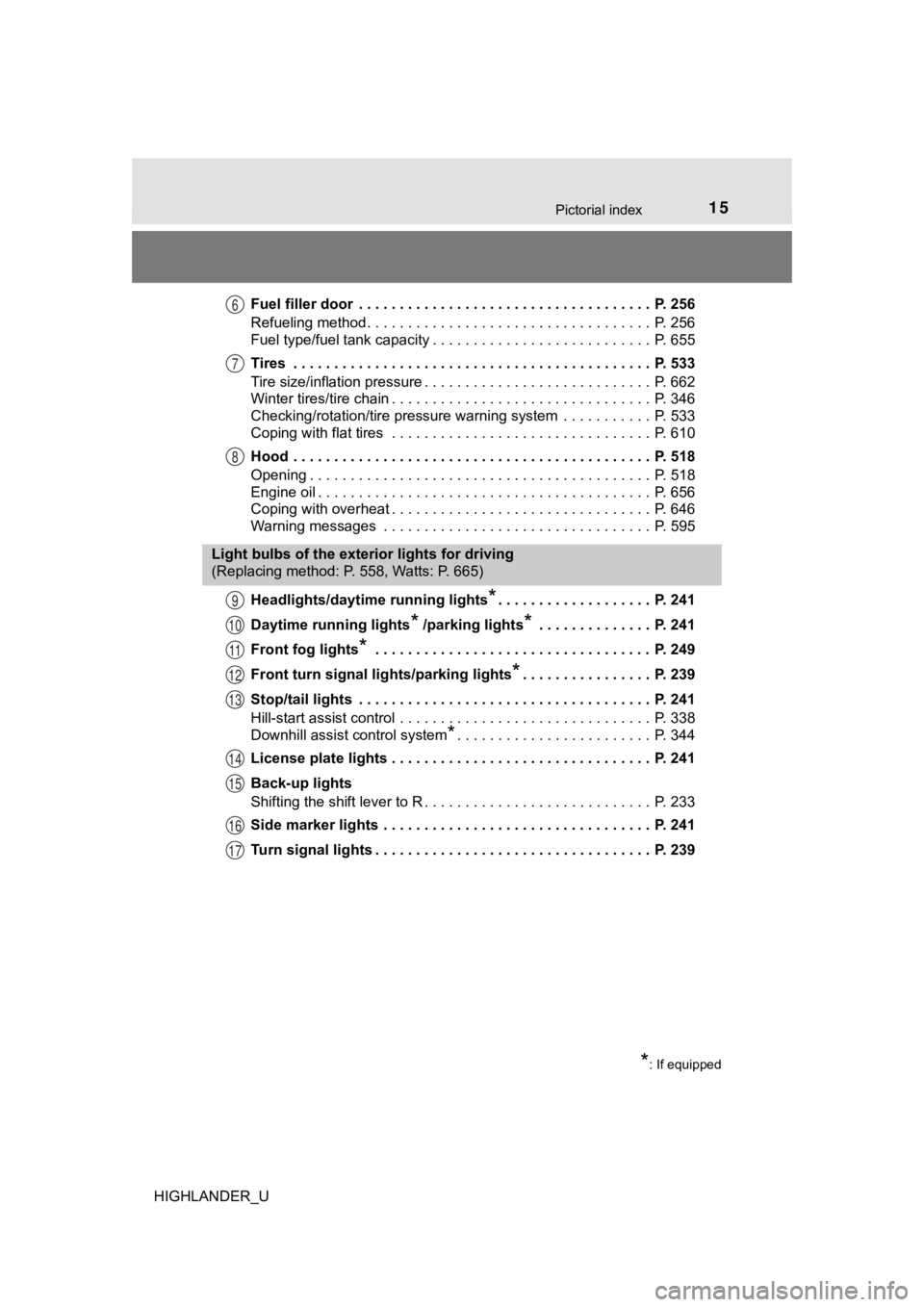
15Pictorial index
HIGHLANDER_UFuel filler door . . . . . . . . . . . . . . . . . . . . . . . . . . . . . . . . . . . . P. 256
Refueling method . . . . . . . . . . . . . . . . . . . . . . . . . . . . . . . . . . . P. 256
Fuel type/fuel tank capacity . . . . . . . . . . . . . . . . . . . . . . . . . . . P. 655
Tires . . . . . . . . . . . . . . . . . . . . . . . . . . . . . . . . . . . . . . . . . . . . P. 533
Tire size/inflation pressure . . . . . . . . . . . . . . . . . .
. . . . . . . . . . P. 662
Winter tires/tire chain . . . . . . . . . . . . . . . . . . . . . . . . . . . . . . . . P. 346
Checking/rotation/tire pressure warning system . . . . . . . . . . . P. 533
Coping with flat tires . . . . . . . . . . . . . . . . . . . . . . . . . . . . . . . . P. 610
Hood . . . . . . . . . . . . . . . . . . . . . . . . . . . . . . . . . . . . . . . . . . . . P. 518
Opening . . . . . . . . . . . . . . . . . . . . . . . . . . . . . . . . . . . . . . . . . . P. 518
Engine oil . . . . . . . . . . . . . . . . . . . . . . . . . . . . . . . . . . . . . . . . . P. 656
Coping with overheat . . . . . . . . . . . . . . . . . . . . . . . . . . . . . . . . P. 646
Warning messages . . . . . . . . . . . . . . . . . . . . . . . . . . . . . . . . . P. 595
Headlights/daytime running lights
*. . . . . . . . . . . . . . . . . . . P. 241
Daytime running lights
* /parking lights* . . . . . . . . . . . . . . P. 241
Front fog lights
* . . . . . . . . . . . . . . . . . . . . . . . . . . . . . . . . . . P. 249
Front turn signal lig hts/parking lights
*. . . . . . . . . . . . . . . . P. 239
Stop/tail lights . . . . . . . . . . . . . . . . . . . . . . . . . . . . . . . . . . . . P. 241
Hill-start assist control . . . . . . . . . . . . . . . . . . . . . . . . . . . . . . . P. 338
Downhill assist control system
*. . . . . . . . . . . . . . . . . . . . . . . . P. 344
License plate lights . . . . . . . . . . . . . . . . . . . . . . . . . . . . . . . . P. 241
Back-up lights
Shifting the shift lever to R . . . . . . . . . . . . . . . . . . . . . . . . . . . . P. 233
Side marker lights . . . . . . . . . . . . . . . . . . . . . . . . . . . . . . . . . P. 241
Turn signal lights . . . . . . . . . . . . . . . . . . . . . . . . . . . . . . . . . . P. 239
6
7
8
Light bulbs of the exterior lights for driving
(Replacing method: P. 558, Watts: P. 665)
*: If equipped
9
10
11
12
13
14
15
16
17
Page 19 of 732
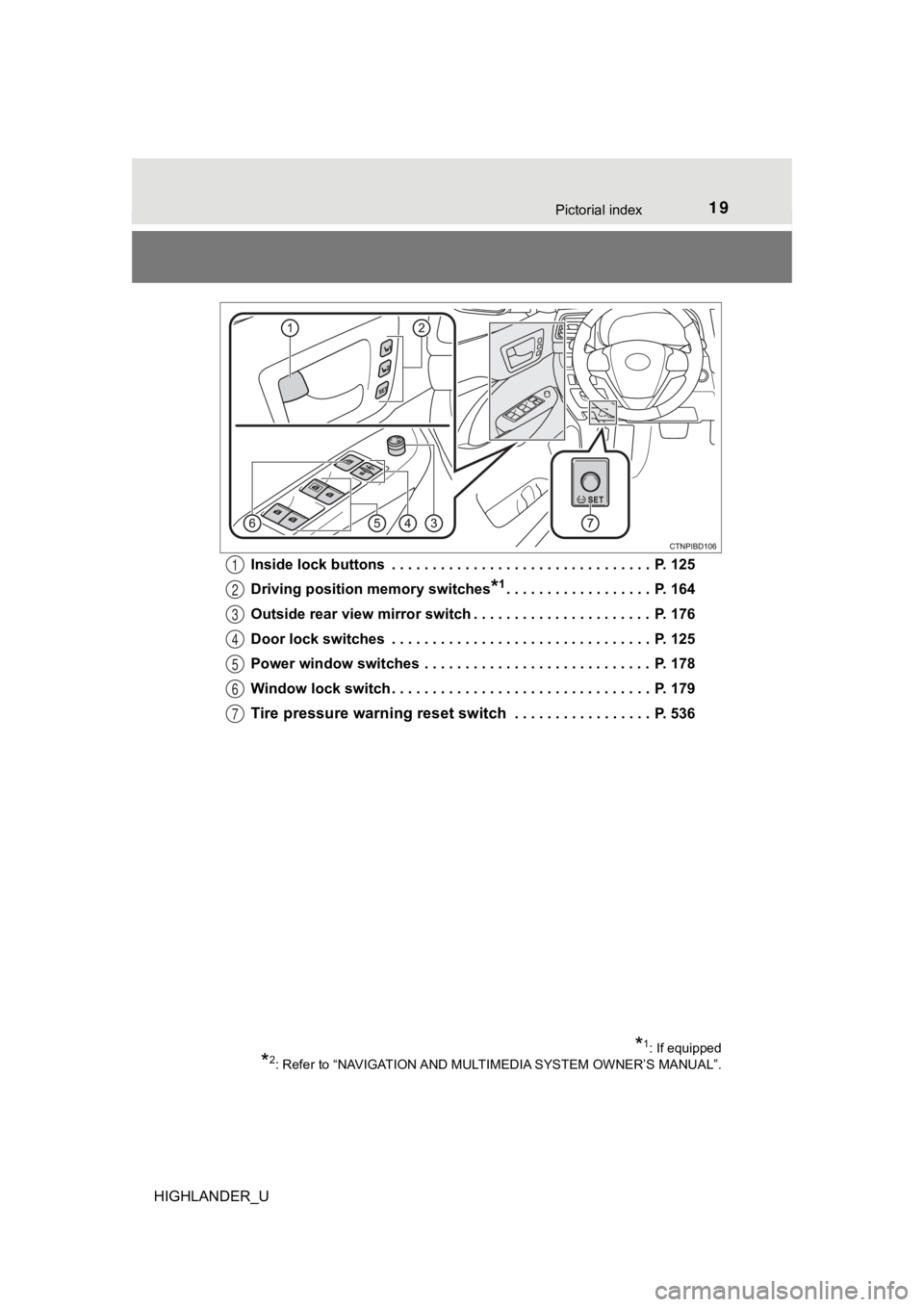
19Pictorial index
HIGHLANDER_UInside lock buttons . . . . . . . . . . . . . . . . . . . . . . . . . . . . . . . . P. 125
Driving position
memory switches
*1. . . . . . . . . . . . . . . . . . P. 164
Outside rear view mirror switch . . . . . . . . . . . . . . . . . . . . . . P. 176
Door lock switches . . . . . . . . . . . . . . . . . . . . . . . . . . . . . . . . P. 125
Power window switches . . . . . . . . . . . . . . . . . . . . . . . . . . . . P. 178
Window lock switch . . . . . . . . . . . . . . . . . . . . . . . . . . . . . . . . P. 179
Tire pressure warn ing reset switch . . . . . . . . . . . . . . . . . P. 536
*1: If equipped
*2: Refer to “NAVIGATION AND MULT IMEDIA SYSTEM OWNER’S MANUAL”.
1
2
3
4
5
6
7
Page 93 of 732
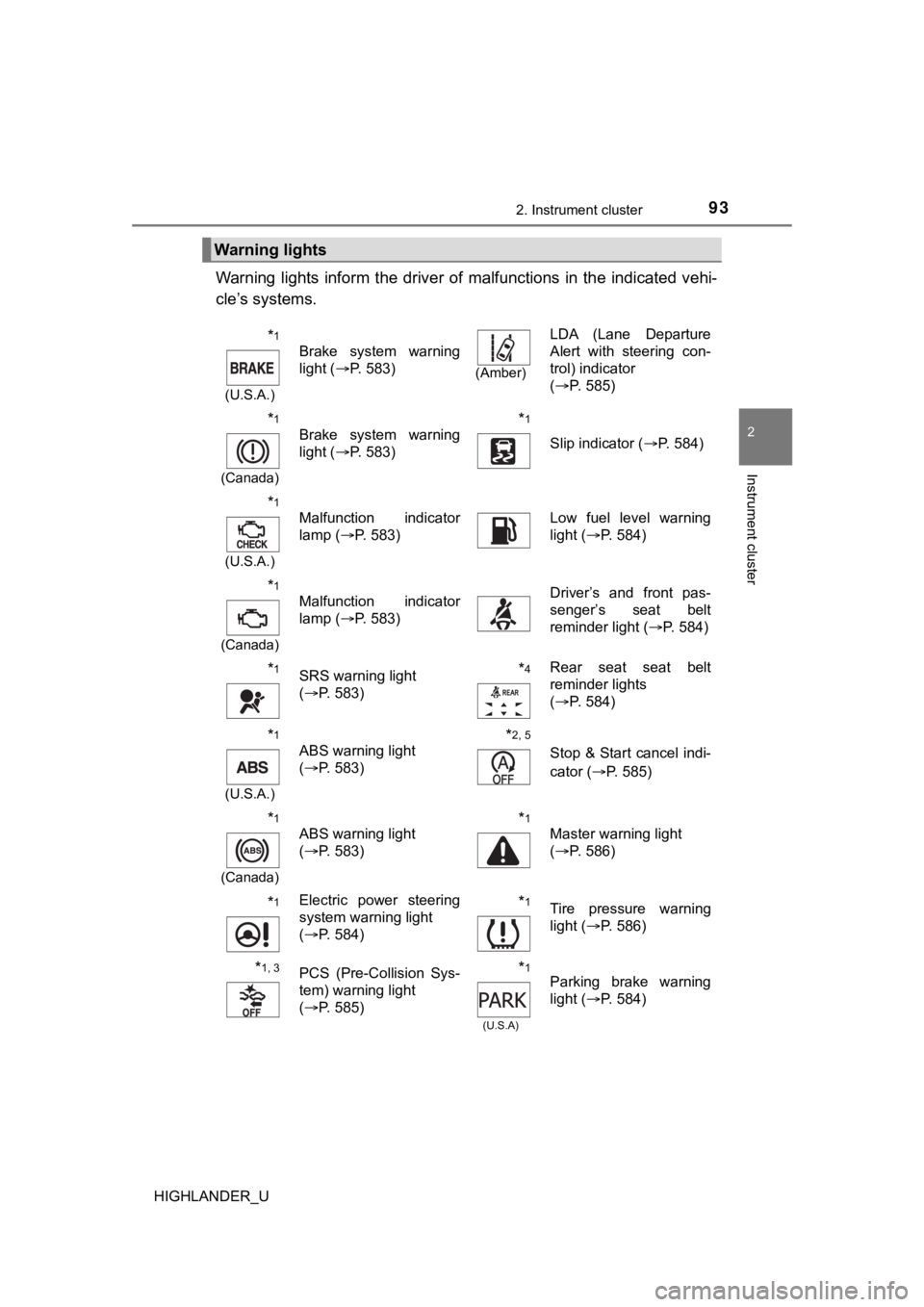
932. Instrument cluster
2
Instrument cluster
HIGHLANDER_U
Warning lights inform the driver of malfunctions in the indicated vehi-
cle’s systems.
Warning lights
*1
(U.S.A.)
Brake system warning
light ( P. 583)
(Amber)
LDA (Lane Departure
Alert with steering con-
trol) indicator
(P. 585)
*1
(Canada)
Brake system warning
light ( P. 583)*1
Slip indicator ( P. 584)
*1
(U.S.A.)
Malfunction indicator
lamp (P. 583)Low fuel level warning
light (P. 584)
*1
(Canada)
Malfunction indicator
lamp ( P. 583)Driver’s and front pas-
senger’s seat belt
reminder light ( P. 584)
*1SRS warning light
(P. 583)*4Rear seat seat belt
reminder lights
(P. 584)
*1
(U.S.A.)
ABS warning light
(P. 583)*2, 5
Stop & Start cancel indi-
cator
(P. 585)
*1
(Canada)
ABS warning light
(P. 583)*1
Master warning light
(P. 586)
*1Electric power steering
system warning light
(P. 584)*1Tire pressure warning
light ( P. 586)
*1, 3PCS (Pre-Collision Sys-
tem) warning light
(P. 585)*1
(U.S.A)
Parking brake warning
light ( P. 584)
Page 278 of 732
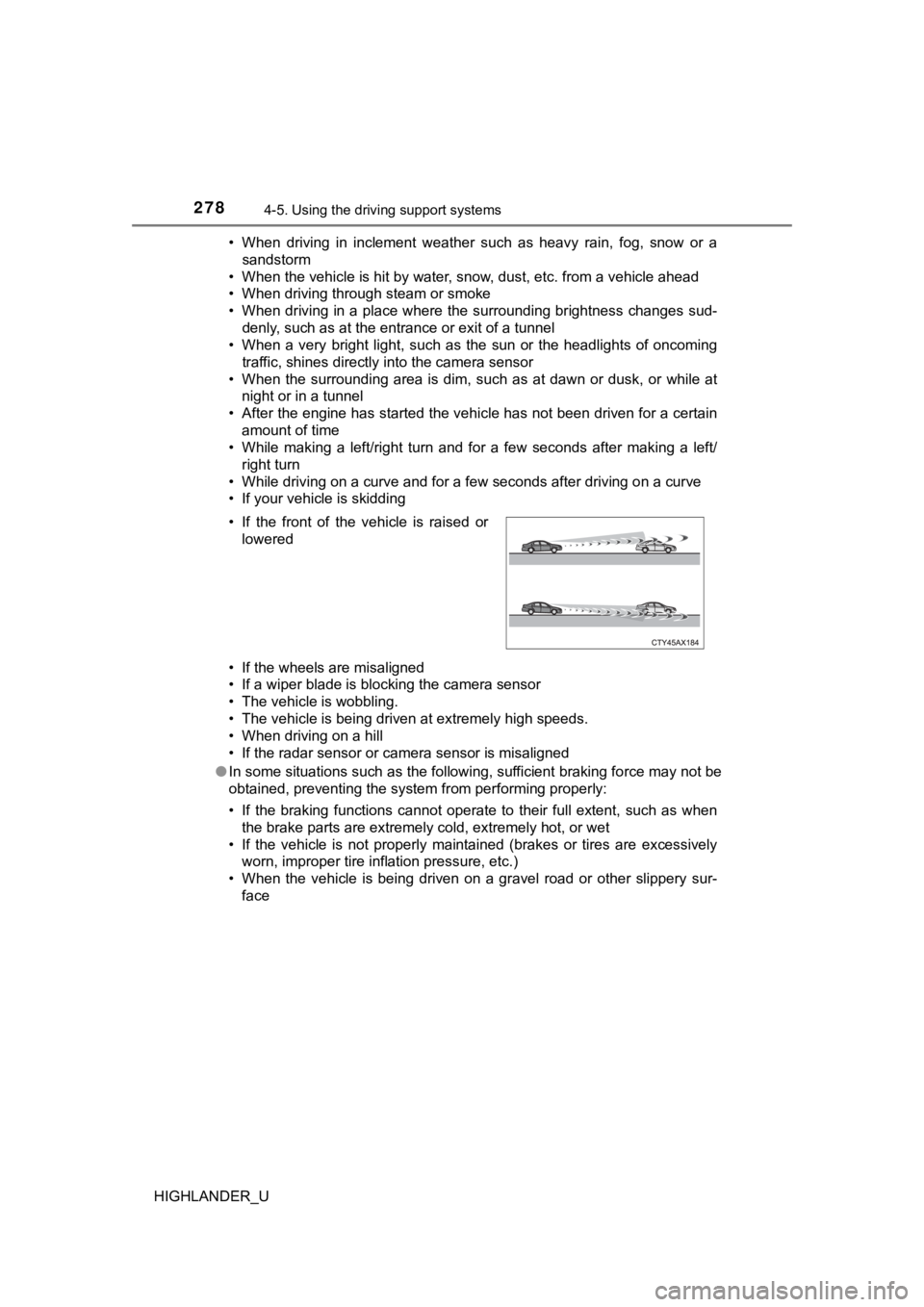
2784-5. Using the driving support systems
HIGHLANDER_U• When driving in inclement weather such as heavy rain, fog, sno
w or a
sandstorm
• When the vehicle is hit by water, snow, dust, etc. from a vehicle ahead
• When driving through steam or smoke
• When driving in a place where the surrounding brightness changes sud- denly, such as at the entrance or exit of a tunnel
• When a very bright light, such as the sun or the headlights of oncoming
traffic, shines directly into the camera sensor
• When the surrounding area is dim, such as at dawn or dusk, or while at
night or in a tunnel
• After the engine has started the vehicle has not been driven for a certain amount of time
• While making a left/right turn and for a few seconds after mak ing a left/
right turn
• While driving on a curve and for a few seconds after driving o n a curve
• If your vehicle is skidding
• If the wheels are misaligned
• If a wiper blade is blocking the camera sensor
• The vehicle is wobbling.
• The vehicle is being driven at extremely high speeds.
• When driving on a hill
• If the radar sensor or camera sensor is misaligned
● In some situations such as the following, sufficient braking fo rce may not be
obtained, preventing the system from performing properly:
• If the braking functions cannot operate to their full extent, such as when
the brake parts are extremely cold, extremely hot, or wet
• If the vehicle is not properly maintained (brakes or tires are excessively
worn, improper tire inflation pressure, etc.)
• When the vehicle is being driven on a gravel road or other sli ppery sur-
face
• If the front of the vehicle is raised or
lowered
Page 289 of 732

2894-5. Using the driving support systems
4
Driving
HIGHLANDER_U■
Conditions in which functions may not operate properly
In the following situations, the camera sensor may not detect w hite (yellow)
lines and various functions may not operate normally.
● There are shadows on the road that run parallel with, or cover, the white
(yellow) lines.
● The vehicle is driven in an area without white (yellow) lines, such as in front
of a tollgate or checkpoint, or at an intersection, etc.
● The white (yellow) lines are cracked, “Botts’ dots”, “Raised pa vement
marker” or stones are present.
● The white (yellow) lines cannot be seen or are difficult to see due to sand,
etc.
● The vehicle is driven on a road surface that is wet due to rain , puddles, etc.
● The traffic lines are yellow (which may be more difficult to re cognize than
lines that are white).
● The white (yellow) lines cross over a curb, etc.
● The vehicle is driven on a bright surface, such as concrete.
● The vehicle is driven on a surface that is bright due to reflec ted light, etc.
● The vehicle is driven in an area where the brightness changes s uddenly,
such as at the entrances and exits of tunnels, etc.
● Light from the headlights of an oncoming vehicle, the sun, etc. enters the
camera.
● The vehicle is driven where the road diverges, merges, etc.
● The vehicle is driven on a slope.
● The vehicle is driven on a road which tilts left or right, or a winding road.
● The vehicle is driven on an unpaved or rough road.
● The vehicle is driven around a sharp curve.
● The traffic lane is excessively narrow or wide.
● The vehicle is extremely tilted due to carrying heavy luggage or having
improper tire pressure.
● The distance to the preceding vehicle is extremely short.
● The vehicle is moving up and down a large amount due to road co nditions
during driving (poor roads or road seams).
● The headlight lenses are dirty and emit a faint amount of light at night, or the
beam axis has deviated.
● The vehicle is struck by a crosswind.
● The vehicle has just changed lanes or crossed an intersection.
● Snow tires, etc. are equipped.
Page 321 of 732
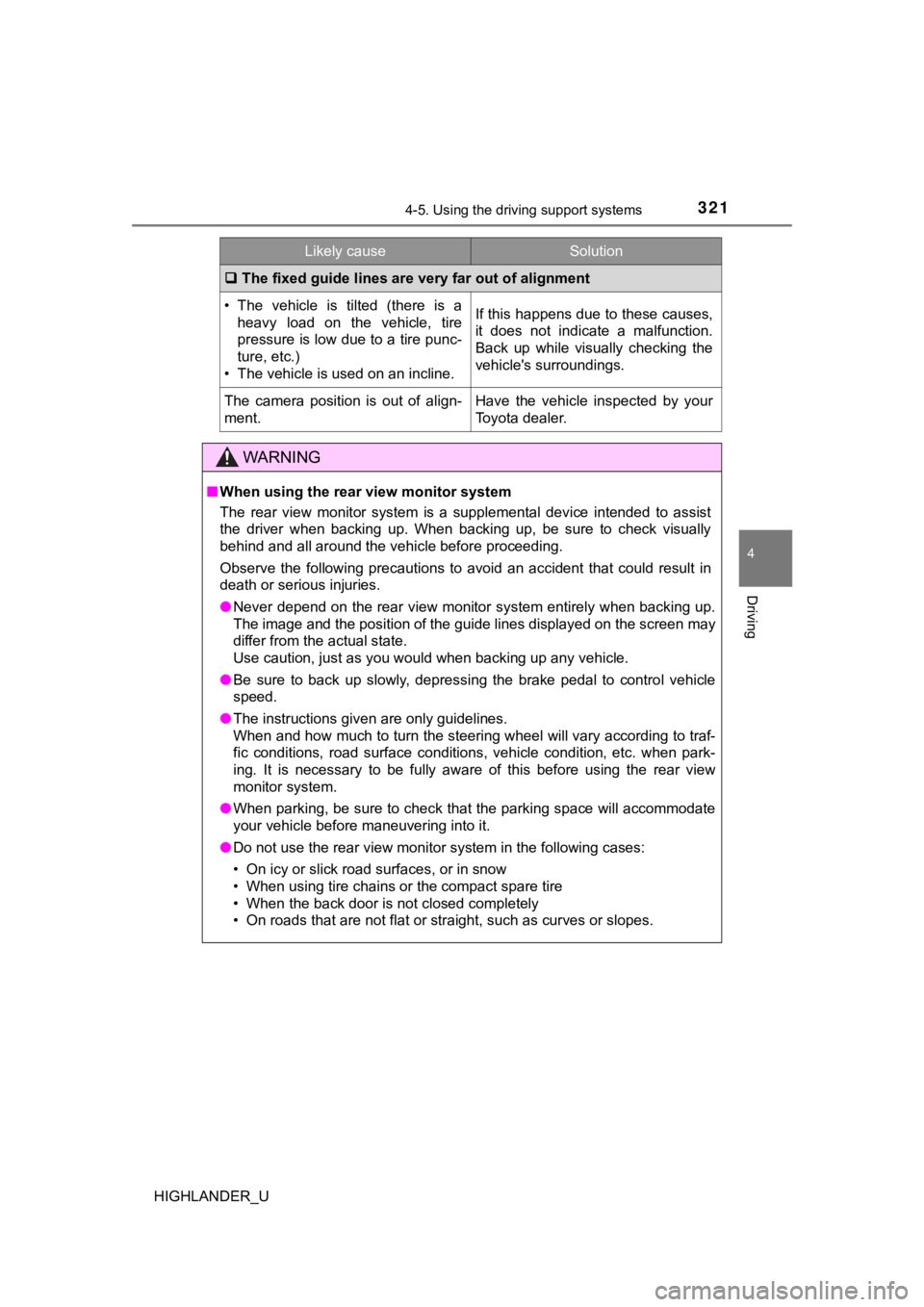
3214-5. Using the driving support systems
4
Driving
HIGHLANDER_U
The fixed guide lines are very far out of alignment
• The vehicle is tilted (there is a
heavy load on the vehicle, tire
pressure is low due to a tire punc-
ture, etc.)
• The vehicle is used on an incline.If this happens due to these causes,
it does not indicate a malfunction.
Back up while visually checking the
vehicle's surroundings.
The camera position is out of align-
ment.Have the vehicle inspected by your
Toyota dealer.
WARNING
■ When using the rear view monitor system
The rear view monitor system is a supplemental device intended to assist
the driver when backing up. When backing up, be sure to check v isually
behind and all around the vehicle before proceeding.
Observe the following precautions to avoid an accident that cou ld result in
death or serious injuries.
● Never depend on the rear view monitor system entirely when back ing up.
The image and the position of the guide lines displayed on the screen may
differ from the actual state.
Use caution, just as you would when backing up any vehicle.
● Be sure to back up slowly, depressing the brake pedal to contro l vehicle
speed.
● The instructions given are only guidelines.
When and how much to turn the steering wheel will vary accordin g to traf-
fic conditions, road surface conditions, vehicle condition, etc . when park-
ing. It is necessary to be fully aware of this before using the rear view
monitor system.
● When parking, be sure to check that the parking space will acco mmodate
your vehicle before maneuvering into it.
● Do not use the rear view monitor system in the following cases:
• On icy or slick road surfaces, or in snow
• When using tire chains or the compact spare tire
• When the back door is not closed completely
• On roads that are not flat or straight, such as curves or slop es.
Likely causeSolution
Page 343 of 732

3434-5. Using the driving support systems
4
Driving
HIGHLANDER_U
WARNING
■TRAC/VSC may not operate effectively when
Directional control and power may not be achievable while driving on slip-
pery road surfaces, even if the TRAC/VSC system is operating.
Drive the vehicle carefully in conditions where stability and p ower may be
lost.
■ Hill- start assist control does not operate effectively when
● Do not overly rely on hill-start assist control. Hill-start ass ist control may
not operate effectively on steep inclines and roads covered wit h ice.
● Unlike the parking brake, hill-start assist control is not inte nded to hold the
vehicle stationary for an extended period of time. Do not attempt to use
hill-start assist control to hold the vehicle on an incline, as doing so may
lead to an accident.
■ When the VSC is activated
The slip indicator light flashes. Always drive carefully. Reckless driving may
cause an accident. Exercise particular care when the indicator light flashes.
■ When the TRAC/VSC systems are turned off
Be especially careful and drive at a speed appropriate to the r oad condi-
tions. As these are the systems to help ensure vehicle stabilit y and driving
force, do not turn the TRAC/VSC systems off unless necessary.
Trailer Sway Control is part of the VSC system and will not ope rate if VSC
turned off or experiences a malfunction.
■ Replacing tires
Make sure that all tires are of the specified size, brand, trea d pattern and
total load capacity. In addition, make sure that the tires are inflated to the
recommended tire inflation pressure level.
The ABS, TRAC and VSC systems will not function correctly if di fferent tires
are installed on the vehicle.
Contact your Toyota dealer for further information when replaci ng tires or
wheels.
■ Handling of tires and the suspension
Using tires with any kind of problem or modifying the suspensio n will affect
the driving assist systems, and may cause a system to malfuncti on.
Page 349 of 732
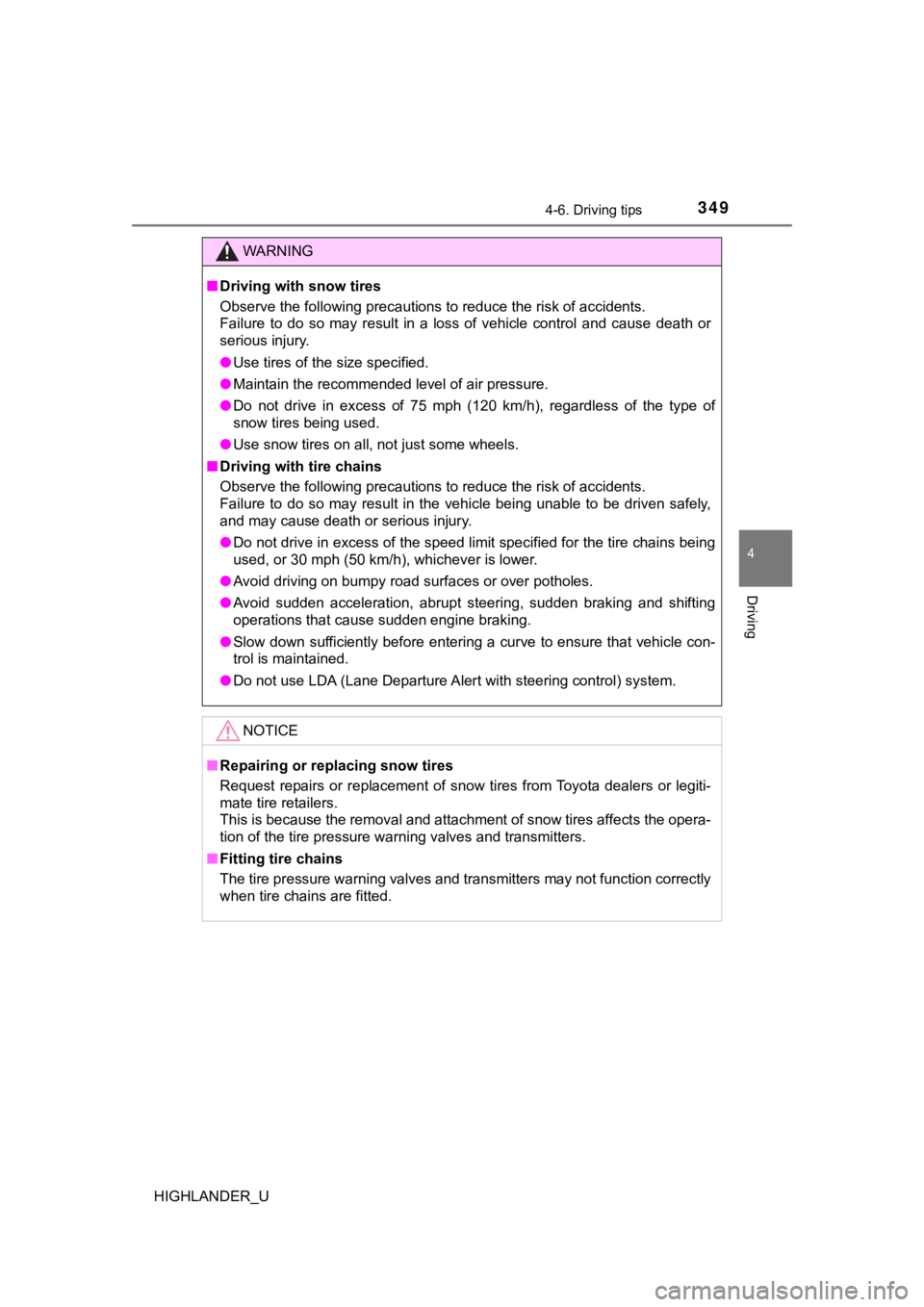
3494-6. Driving tips
4
Driving
HIGHLANDER_U
WARNING
■Driving with snow tires
Observe the following precautions to reduce the risk of acciden ts.
Failure to do so may result in a loss of vehicle control and ca use death or
serious injury.
● Use tires of the size specified.
● Maintain the recommended level of air pressure.
● Do not drive in excess of 75 mph (120 km/h), regardless of the type of
snow tires being used.
● Use snow tires on all, not just some wheels.
■ Driving with tire chains
Observe the following precautions to reduce the risk of acciden ts.
Failure to do so may result in the vehicle being unable to be d riven safely,
and may cause death or serious injury.
● Do not drive in excess of the speed limit specified for the tir e chains being
used, or 30 mph (50 km/h), whichever is lower.
● Avoid driving on bumpy road surfaces or over potholes.
● Avoid sudden acceleration, abrupt steering, sudden braking and shifting
operations that cause sudden engine braking.
● Slow down sufficiently before entering a curve to ensure that v ehicle con-
trol is maintained.
● Do not use LDA (Lane Departure Alert with steering control) sys tem.
NOTICE
■Repairing or replacing snow tires
Request repairs or replacement of snow tires from Toyota dealer s or legiti-
mate tire retailers.
This is because the removal and attachment of snow tires affect s the opera-
tion of the tire pressure warning valves and transmitters.
■ Fitting tire chains
The tire pressure warning valves and transmitters may not funct ion correctly
when tire chains are fitted.
Page 501 of 732

501
7Maintenance and care
HIGHLANDER_U7-1. Maintenance and care
Cleaning and protecting the vehicle exterior .......... 502
Cleaning and protecting the vehicle interior ........... 506
7-2. Maintenance Maintenance requirements ................... 509
General maintenance........ 512
Emission inspection and maintenance (I/M)
programs......................... 515
7-3. Do-it-yourself maintenance
Do-it-yourself service precautions ..................... 516
Hood ................................. 518
Positioning a floor jack ...... 520
Engine compartment ......... 521
Tires .................................. 533
Tire inflation pressure ....... 544
Wheels .............................. 547
Air conditioning filter.......... 549
Wireless remote control/ electronic key battery ...... 551
Checking and replacing fuses ............................... 554
Light bulbs......................... 558